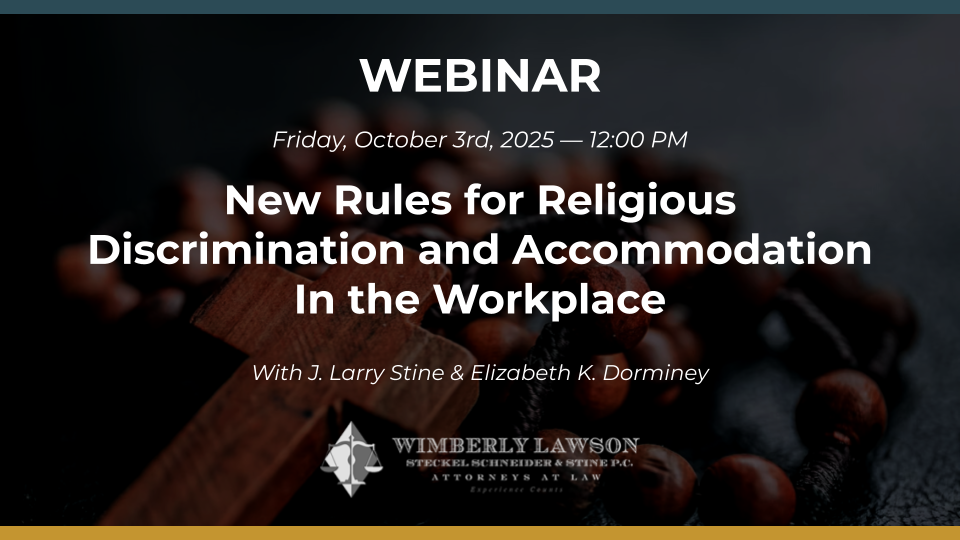OFCCP PROPOSING "EQUAL PAY" REPORTS TO FURTHER ADD TO BURDENS OF FEDERAL GOVERNMENT CONTRACTORS
On August 8, the Office of Federal Contract Compliance Programs (OFCCP) proposed to amend its implementing regulations for Executive Order 11246, which sets forth the reporting obligations of federal contractors and subcontractors. The amendment would add a requirement that employers who file EEO-1 reports, have more than 100 employees, and a contract, subcontract, or purchase order amounting to $50,000.00 or more that covers a period of at least thirty (30) days, submit additional information in a new Equal Pay Report to OFCCP. The public may submit comments on the proposed regulations which must be received on or before November 6, 2014.
The gist of the proposed rule is that contractors filing EEO-1 reports would be required to provide aggregate EEO-1 classification annual earnings by category annually, based on annual W-2 reports. OFCCP would come up with some type of national, regional, or other breakdown by industry to develop "norms" for that industry based on these EEO-1 categories, so that both OFCCP and the contractors themselves could see how they stood in relation to the industry. The data would be analyzed separately by sex and the same racial categories used in EEO-1 reports. The idea would then be for OFCCP to encourage contractors to improve their demographic workforce as compared to the industry, and for OFCCP to use such data to select which contractors to be subject to a compliance review.
The proposal is rather vague as to how the OFCCP is going to aggregate and analyze the data received, and publish the industry-wide data. However, the overall concepts are more obvious, and the OFCCP has the argument that they are requiring the data in a format more likely readily available to contractors, which is annualized W-2 earnings broken down into EEO-1 categories.
There is something unstated anywhere in the proposed regulations that is very disturbing, but it must be very tactfully presented in making any public comments on the proposal. In civil litigation, plaintiffs routinely request copies of employers' EEO-1 reports. Once the equal pay proposal goes into effect, plaintiffs will obviously request the aggregate pay data from defendant employers that they have provided to the OFCCP. Plaintiffs will use such data to great assistance in bringing discrimination class actions against the employer. Further, special interest groups may bring litigation for the purpose of getting such data, and using it in political, civil rights or union organizing campaigns to "expose" the employer as one that practices discrimination and "cheats" the disadvantaged groups. It is not hard to imagine how such data could be used to disadvantage other industry employers.
There may be a way for activists to get such information without even suing the employer. That is, activists can request data from the OFCCP under the Freedom of Information Act (FOIA), and the proposed regulations are not as strong as they could be as to the ability of the OFCCP to protect such information from FOIA requests. Further, the OFCCP plans to publish the pay ranges by industry, labor market, or other groupings, and one should expect such industry pay data to show up on organizing campaign handouts by unions all across the country, at least in the case of industry employers paying less than those "norms." The proposals indicated that the submitter of the information may designate by appropriate markings any portion that it considers to be protected from disclosure under the FOIA, and the proposed regulations require OFCCP to notify the submitter on a case-by-case basis whenever an FOIA request is made for such information. The OFCCP claims it is "not aware" of any instance in which such compensation data has been disclosed without the consent of the submitter.
The above discussion about the information requests probably leads to a point in which the proposed regulations may be of special concern. That is, an argument can be made that competitors can use the data secured in information requests from the OFCCP to "raid" the workforces of their competitors. This would certainly be an argument for the industry to consider if it chooses to oppose the regulations.
Another possible but broader way to attack or address the proposed regulations is the context of the numerous additional requirements being placed upon government contractors. That is, in the course of less than six months, proposals have been made to require government contractors to do the following: (1) adopt a $10.10 per hour minimum wage for the employees of certain federal contractors; (2) disclose to federal agencies violations of 14 federal employment/labor laws to be considered in the bidding process; (3) implement new OFCCP rules on affirmative action for veterans and the disabled; (4) ban sexual orientation and gender identity discrimination of federal contractors; (5) prohibit federal contractors from maintaining pay secrecy policies; and (6) implement new proposed equal pay rules.
Related Content
Get Email Updates
Recent Content

New Rules for Religious Discrimination and Accommodation In the Workplace

TPS Update (as of 9/3/2025)

DOL To Shut Down OFCCP and Transfer Duties to EEOC

Meaning of Supreme Court Ruling Limiting Nationwide Injunctions in Birthright Case

In Spite of Adminstration Changes, Monitoring of the Workplace Continues to Create Legal Issues

